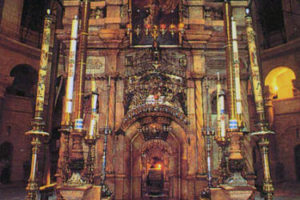In Dating the Crucifixion (Part 1), seven events all pointed to and collectively confirmed 31 CE as the year of the Crucifixion. These events were: (1) the expelling of the Sanhedrin from the Hewn Stone-Chamber (Babylonian Talmud, Sanhedrin 41:2), (2) the 46th Year of Temple Reconstruction, (3) the Fifteenth Year of Tiberius (Luke 3:1 NASB), (4) Jesus’ Visit to the Synagogue at Nazareth, (5) the Second-First Sabbath (Luke 6:1 NASB), (6) the arrival of Pilate, and (7) the Lunar Eclipse at the Crucifixion (Acts 2:17-21 NASB). But the Hebrew Perpetual Calendar places the Passover in 31 CE on Mon., Mar. 26. Yet, in fact, the Passover occurred on Wed., April 25, 31 CE (that being Nisan 14, 3791 AM). The question is, Why the discrepancy?
In Jesus’ day, when the sacrificial system and the Jerusalem Temple were in place, the priests utilized calculation including a rule allowing a one-month postponement when the impact of cold weather thwarted the proper observation of the Passover. At times unusually cold weather significantly impeded the ripening of the barley crop and delayed the development of fruit on the fruit trees. These two conditions, when they occurred together, allowed a one-month calendar postponement. The simple solution of dealing with late springs (when the vernal equinox fell on Nisan 16 or later), the delayed development of the fruit trees, and the impeding of the ripening of the barley crop, was that when two of these events were present the high priest could intercalate by adding Adar II (a 30-day month) to the ending sacred year. This would ensure the barley crop was ready (in the abib state) and the wave sheaf was ready for the required offering. The high priest took this action in 31 CE.
According to the Talmud, the priests exercised their authority to add a 30-day month (Adar II) when cold weather significantly impeded the ripening of the barley crop and delayed the development of fruit on the fruit trees (Danby, H., 1919, p. 31). These two conditions, when they occurred together, triggered authority for making a calendar postponement. In a post-sacrificial world, the reduction of calendar rules to mathematical statements yields a mathematical model providing a universal perpetual calendar for Jews and Judeo-Christians. Until the 4th century CE, the basic rules of the calculated calendar, with all its intricacies, were secret but known and presumably used only by select members of the Sanhedrin.
There are five corroborations of the addition of Adar II by intercalation of year 3791 AM such that the Passover fell on April 25, 31 CE. These are: (1) the leaved fig tree without fruit, (2) the fishing season on Lake Tiberius (the Sea of Galilee), (3) the earthquake season in the Syria Palestine, (4) the late spring of 31 CE, and (5) the blood-red lunar eclipse from 8:26 p.m. to 11:46 p.m. Jerusalem time on April 25, 31 CE.
1. The Leaved Fig Tree
Upon leaving Bethany, Jesus being hungry, observed a fig tree which had leaves but found no fruit to eat (Matthew 21:18-19 NASB; Mark 11:12-14 NASB). This was Sunday, Nisan 11, or April 22 Julian) three days before his Crucifixion. Mark’s Gospel records that in the highlands about Jerusalem the “time of figs was not yet” (Mark 11:13 NASB). Nevertheless, in this orchard there existed an isolated tree in full leaf but without any figs. Luke reports that in other orchards other kinds of trees were putting forth their leaves as well (Luke 21:29-30 NASB).
Writing in the Journal of Biblical Literature, Grace Amadon explains:
In early April, the fig trees in Palestine, around Jerusalem, have little green figs only — no leaves. If the crucifixion passover had been in early April, none of the trees would have been in leaf. Hence the fig tree with such abundant foliage, and the leafing out of other trees also, are witnesses to the lateness of the death passover of Christ. Furthermore, Jesus himself said, “Summer is now nigh at hand” (Luke 21 30).
Amadon, 1942, p. 273.
In early April, the fig trees around Jerusalem first developed little green figs but no leaves. These starchy vegetable-tasting small knobs, called taqsh by the Arabs, are a sort of forerunner of the real figs. The consumers of these taqsh are peasants as well as others when hungry. The taqsh drop off before formation of the real fig.
This evidence eliminates both April 5, 30 CE and March 26, 31 CE as possible Passover dates in the year of the Crucifixion because there would be no leaves just the taqsh.
2. The Fishing Season on Lake Tiberius
Following the Resurrection, Peter and several friends went fishing on the Lake Tiberius. About the second week of May, the group caught nothing after fishing all-night. In the morning, Jesus performed a miracle providing them with fish (John 21:3-8 NASB).
The fact that fishing was not good in waters which in season teems with large fish a few yards out from shore, suggests Passover was late in 31 CE, that is, at the end of the fishing season. According to Amadon:
There is uniform testimony that the Galilean fishing season is from mid- December or January to April. In the very early spring before the crucifixion, Peter could readily hook up a fish off the shore of Galilee (Mat 17 27), “where the shallows swarm with small fish fry.” In the second week after the crucifixion, Peter and his comrades caught nothing after an all night attempt on the lake. Then came the early morning catch at the command of the Master.
Amadon, 1942, p. 273.
If the Nisan 14 Passover had occurred Mon., March 26 as the Hebrew Perpetual Calendar places it in 31 CE or Wednesday, April 5 in 30 CE, then fishing would still have been good for a few weeks. Adding the intercalary month of Adar II before Nisan placed the Nisan 14 Passover on Wednesday, April 25.
Amadon concludes that:
If the crucifixion had occurred early in April, as would necessarily have been the case in 30 A.D., then fishing would still have been good for a few weeks. But the fact that it was not good in water that in season teems with large fish a few yards out from shore, is an indication that the passover was late, that is, that the fishing period was coming to its end. Hence the occurrence of the miracle.
Amadon, 1942, p. 273.
This evidence eliminates both April 5, 30 CE and March 26, 31 CE as possible Passover dates in the year of the Crucifixion. The evidence verifies the priestly declaration of a leap year in 31 CE.
3. The Earthquake Season in Syria Palestine
The Gospels record an earthquake at the death of Christ and another in the early hours of Sunday morning on the day after his Resurrection. Amadon recognized the significance of these earthquakes for they attest that the annual earthquake season in Syria Palestine had begun thereby evidencing a late Passover. In her words:
The biblical earthquakes outline a period from the end of the paschal season to the middle of summer, or not long after. At the dividing of the Red Sea, and of the Jordan river, the mountains “trembled” (Hab 2 10); at the giving of the law at Sinai, the “earth shook” (Ps 68 8); the fall of Jericho, Jonathan’s victory at Michmash, the presumption of Uzziah, Paul and Silas in stocks at Philippi — these are other Incidents accompanied by earthquake* It can be shown that all of these were after-passover or summer events. And to this series belong the two crucifixion earthquakes — one at the death of Christ, and the other at the resurrection. They obviously mark an early beginning for the earthquake season in that year, and are witness to the lateness of the crucifixion passover.
Amadon, 1942, p. 273.
Known biblical earthquakes define a season spanning the end of the paschal season to about the middle of summer.
4. The Late Spring of 31 CE
The spring equinox in 31 CE was Wed., March 21 (Julian) and Nisan 9, well before the Passover of Nisan 14. There was no late equinox in 31 CE.
Did you ever notice, however, that on the eve of the Crucifixion that it was so cold that Peter “sat with the servants and warmed himself at the fire?” (Mark 14:54 NASB; Luke 22:55-60 NASB) and “the servants and officers who had made a fire of coals stood there, for it was cold, and they warmed themselves. And Peter stood with them and warmed himself” (John 18:18 NASB).
If it was that cold on April 25, consider how cold it was about six weeks earlier when the high priest had to come to a decision on whether to proclaim a new year or declare a postponement. Such intercalation was sometimes enjoined only late in First Adar.
By Monday, March 12 (Julian), the 29th of Adar I, the high priest had to be ready to proclaim the following day (Tuesday, March 13) either a new year or a postponement. By the last day of First Adar I (Adar I) the high priest had to determine if the spring barley crop would be ready for harvest by Passover. The evidence of the fig tree, the fishing season and the earthquake season suggest the decision he made was that the barley would not be ready for harvest for a March 26 Passover.
There is some evidence that the weather preceding the Crucifixion Passover may also have delayed the lambing season. This would have occurred if the mating date was later than normal. Considering the importance of an adequate supply of Passover lambs, experienced shepherd-priests of Migdal Eder were not only aware of when the mating of their ewes began in the late summer and the gestation period of ewes but would certainly closely watch the ewe flocks in the days running up to the start of lambing. The high priest would expect to learn from the Temple’s priest-shepherds if they expected such a delay.
As a practical matter, the priest-shepherds would keep watch for swelling of the ewes’ udders, for a few days before the ewe gives birth her udder swells as milk production begins. Her vulva becomes pink and expands in readiness for birth.
Lambs had to be at least 8 days old and in sufficient quantity by Nisan 14 for Passover sacrifice. This would require the birth of a Passover lamb no later than March 15, 31 CE. A breeding date of October 19, 30 CE would give an expected lambing/kidding date of March 15, 31 CE (based on 147-day gestation). Birthing could occur March 5-27 (the range based on 138 days to 159 days). “The net effect of the slow onset of mating and low conception rates is to delay the median lambing date, and it contributes to a large spread in lambing” (Knight, 1980, p. 281).
Shepherds know that a cold spell in the autumn may “bring ewes on” sooner than when the weather is warmer. The converse is that any unusually warmer autumn postponed mating. This means that if breeding began late, after November 1, it would push the beginning of the lambing season into April. Breeding ewes in late October through early December ensures that all ewes of any merit are fertile. Rams are also more fertile in this time period. Spring lambing coincides with the natural breeding and lambing seasons.
Such calendar adjustments are no longer necessary in traditional Judaism as the Temple sacrificial and offerings system no longer exists. This permits the use of the perpetual calendar in present-day Judaism. When a new Third Temple is built and sanctified, the Jews will reinstitute the sacrifices and offering system. They may decide to adjust their use of the Hebrew Perpetual Calendar to deal with the realities of the weather at Jerusalem at Passover.
5. Blood-Red Lunar Eclipse
Some proponents of the Wednesday, April 25, 31 CE date for the Crucifixion point out a blood-red lunar eclipse from 8:26 p.m. to 11:46 p.m. that Wednesday night. Similarly, some advocates of a Friday, April 3, 33 CE Crucifixion refer to the blood-red moon and partial lunar eclipse that Friday night. While there was a partial lunar eclipse on April 25, 31 CE an on Friday, April 3, 33 CE. There was no lunar eclipse at Passover time on either March 26, 31 CE or April 5, 30 CE.
At Acts 2:17-21 NASB, the Apostle Peter quotes Joel 2:28-32 NASB. According to Anthony Alfieri, the Apostle Peter in Acts 2 upheld, at the very least, that the night following the Crucifixion included a partial lunar eclipse and a blood red moon. If, indeed, Peter conveyed that thought, then he confirms 31 CE and not 30 CE as the year of the Crucifixion.
Alfieri, as some others, argue that the blood-red moon of April 25, 31 CE, following Jesus’ death, was “virtually centered over Jerusalem by the time it finished, but not exactly” (Alfieri, 2005, p. 407). You can verify the lunar eclipse on the NASA Eclipse Website See https://eclipse.gsfc.nasa.gov/eclipse.html. The duration of its blood-red eclipse phase was about 2 hours and 4 minutes peaking in color at approximately 9:40 p.m. (Alfieri, 2005, pp. 392, 395).
Joel 2:30-32 NASB refers to the Day of the Lord wherein “The sun shall be turned into darkness, and the moon into blood, before the coming of the great and awesome day of the Lord” (Joel 2:31 NASB). This prophecy tells of the blocking of the sun’s light and the moon having a reddish appearance, like blood suggesting an eclipse visible in Israel just before the second coming of Christ.

Jesus spoke of this event in: “Immediately after the tribulation of those days the sun will be darkened, and the moon will not give its light, and the stars will fall from heaven, and the powers of the heavens will be shaken” (Matthew 24:29-30 NASB).
The language of Joel 2:31 NASB, however, about the darkening of the sun, a blood-red moon, and “the Day of the Lord” coincide better with Revelation 6:12 NASB, which addresses the end of the age when Christ returns to establish his kingdom. Thus, some have misgivings about Joel’s prophecy being fulfilled at the time of the Crucifixion.
Image taken from the NASA Technical Publication “Five Millennium Canon of Lunar Eclipses: -1999 to +3000″ by Fred Espenak and Jean Meeus.) NASA TP-2009-214172. Image public domain, courtesy NASA, as a U.S. Federal Government “work prepared by an officer or employee of the United States Government as part of that person’s official duties” 17 U.S.C. § 101.
Serious arguments exist for and against the prophetic necessity of a blood-red moon the evening of the partial lunar eclipse. So, in this case, confirmation remains an open question.
In conclusion, several first-century events pointed to and collectively confirm 31 CE as the year of the Crucifixion.




Recent Comments